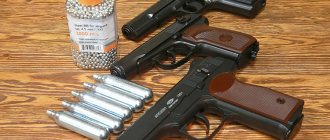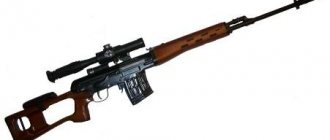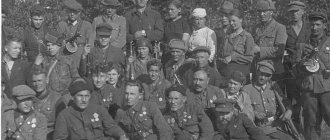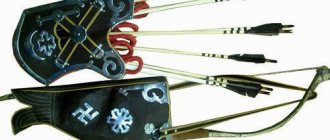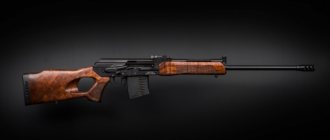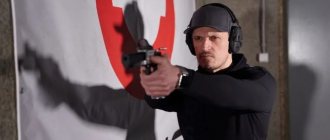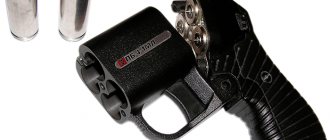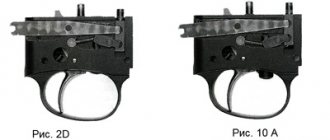Smoothbore firearms
The definition comes from its name. The barrel bore in cross section is an even circle, without depressions or grooves. This design is maintained along the entire length. In some cases, choke constrictions occur, but the shape remains constant. This category includes: hunting single-barreled and double-barreled shotguns of various types and modifications, gas pistols. According to the reloading method, they are divided: pump-action and self-loading and with a breaking mechanism.
Almost any ammunition can be used in a smoothbore rifle. In addition to shot, you can shoot buckshot and bullets, which is very important when hunting large animals. The most common cartridges are 12 gauge . Other sizes are much less common.
Smoothbore weapons are widely popular today. If you are about to purchase your first firearm or pistol, then you are allowed to use only this category for 5 years. This is due to the simplicity of the design, as well as the short firing range. The main area of application for a smooth barrel is hunting. Due to its high combat capabilities, it is also used for official purposes and self-defense.
Let's look at its strengths and weaknesses.
Advantages:
- Affordable price . The cost of hunting rifles starts at about 20 thousand rubles.
- Extensive selection of ammunition . In addition to shot, you can use buckshot, bullets or rubber cartridges.
- Accurate shooting at moving targets . Smoothbore rifles are popular with most hunters.
Flaws:
- Short firing range . On average it is 50 meters.
- Low tactical capabilities of the shooter . This is due to the large dimensions.
Which barrel is better?
The old adage that the barrel shoots and the stock hits clearly shows how much importance is placed on the barrel when fitting a gun to the shooter. There are many ways to make barrels, each of which has its own characteristics, advantages and disadvantages. These individual traits are the topic of the article.
Whether the barrel will give the accuracy expected by the shooter depends not only on the pitch of the rifling, which is suitable for the caliber, weight of the bullet and powder charge, but, first of all, on the base material, the size match and the care with which the barrel is made. Almost all models of long-barreled weapons for shooting bullets (with the exception of certain models chambered for Flaubert and pneumatic weapons) have rifled barrels, that is, those that, for accurate shooting with single shots, have deep grooves inside and protruding fields with sharp edges. Such a screw thread cuts into the leading surface of the bullet and gives it a rotational movement relative to its own longitudinal axis, making possible stable movement of the bullet along the trajectory. The same function is performed by rounded arcs of a circle, smoothly flowing into each other, which form a soft-flowing polygonal profile without sharp edges. It deforms the bullet and also causes it to rotate.
This sometimes gives reason to assume that even today trunks are cut exclusively using traditional technology - by removing chips. But this is far from true. Previously, there was no alternative to this technology, but since then manufacturers have switched to more modern and much less material-intensive processes. For example, barrels can also be produced by mandrel burnishing (direct and reverse), forging and the so-called electrochemical method.
There are very few steel manufacturers in the world who can or have the desire to produce a source material that is absolutely specific in the totality of its properties and almost perfectly meets the requirements for gun barrels. One of them is the American company Carpenter Technology Corporation, whose headquarters are located in Reading, Pennsylvania. This company incurs particularly high production costs. Meticulous quality control (including constant monitoring of individual workpieces for scratches and deviations from cylindrical shape) throughout the entire technological process should ensure the absolute absence of structural defects in each workpiece. When it comes to the best starting base for producing stable, high-precision barrels of the highest quality, the legendary Carpenter stainless steels 416R (here R stands for rifle barrel steel) and 416RS for barrels are by far the first choice today. with particularly thick walls (here S stands for high sulfur content). In addition, these high chromium steel grades provide less wear on very expensive tools and allow for significantly higher machining speeds than most other steel grades.
Since the very beginning of mass industrial production, barrel blanks have been produced mainly by rolling. They are then machined, refined and drilled using a deep hole drilling machine. Finally, the surface of the bore is honed. After this, the cuts are obtained using one of the methods described in this article.
A rifled barrel is a barrel whose internal profile is formed in such a way that, due to controlled deformation of rotation, it stabilizes the bullet on its trajectory. This name goes back to one of the methods described here for obtaining an internal profile - the cutting method. And although there are other technological options, with the exception of barrels with a cylindrical internal surface, they are always called rifled.
CUTTING TRUNKS
The technologically outdated method of producing rifling by removing chips is today, of course, the rarest technological method. Here, each cut, one after another, is processed individually by the blade of a tool called a trellis, and by moving the tool in steps, it cuts deeper and deeper until the desired profile is obtained. In this case, either the fixed barrel blank or the trellis rod rotates to obtain spiral grooves (the author describes the technological process of cutting with a hook trellis; for more than a hundred years there has been a method of trellis cutting, in which the number of “brushes” - the cutting elements of the trellis is equal to the number of grooves, and cutting happens simultaneously - translator's note). The rifling is carried out on a barrel cutting machine, which allows you to precisely execute the desired rifling pitch, accurately preset the rifling depth, and accurately track the rifling with each pass.
The basis of the basics. The weapon barrel blank must meet high quality requirements, otherwise the finished barrel will not give the best results
Finally, rough surfaces are smoothed using a lapping surface. The minimal stresses that arise during this process are eliminated by heat treatment, in which the barrels in a vertical position are heated in a furnace to a certain temperature and cooled very slowly. After 24 hours, the trunks can be handled (at least with gloves) and removed from the oven. Disadvantage: This traditional cutting method cuts the fibers of the material and thereby destroys its internal structure. In this case, of course, strength suffers (compression, tension, bending, torsion). Despite this, elite barrels, for example from the American companies Bartline and Krieger, are still produced using this old method.
Burling (punching and pulling) refers to methods of cold deformation without removing chips. Here, on a machine, with great force, a hard metal rod, the so-called mandrel with an outer profile opposite to the profile of the barrel bore, is pressed or pulled through a fixedly fixed barrel blank with a smooth hole with a diameter slightly smaller than the caliber. This mirror-like mandrel not only forms fields and grooves, but also simultaneously compacts the material and thus provides a noticeably lower surface roughness compared to traditional machining methods by chip removal. Since mandrel barrels currently have a tensile strength of up to 1050 N/mm2 and their surface must be carefully honed to reduce the pressing force, they are almost as good as forged barrels in terms of surface quality. But still, after such a difficult operation, the trunks often need to be straightened - this is what is called restoring the straightness of the bore axis.
From a solid workpiece: after deep drilling of the workpiece, the holes should be concentric with the outer surface along the entire length
Due to the fact that deformation occurs “only” on the inner surface, such large stresses do not arise in the metal structure as during forging. They are eliminated by vacuum tempering, which involves heating the barrels, placed individually in an oven, where they are then slowly cooled overnight. Often, at the end, additional deep cooling is carried out in a liquid nitrogen environment. And since during mandrel it can often happen that the profile of the barrel bore is not 100% located along the axis of the barrel blank and is imprinted unevenly, then when manufacturing precision barrels, a mandrel soldered to the holder with a profile opposite to the channel with rifling is pulled through the barrel bore. At the same time, the mandrel makes a forced screw movement, and as a result, the axis of the barrel bore from the muzzle to the breech runs exactly along the axis of symmetry of the barrel. Then an experienced specialist checks the straightness in the old proven way, with the naked eye, using a shadow triangle, and, if necessary, straightens the barrel.
FORGING METHOD
In so-called rotational forging, which is also a method of cold deformation without chip removal, preparation is carried out in a similar way. But it is necessary to distinguish between two methods. The method used by the Austrian firm GFM GmbH Steyr is called "hydraulic forging" because their machines forge barrels with standing prismatic firing pins that are hydraulically driven while the barrel blank rotates. Since in many cases the chamber is also forged together, large degrees of deformation occur with correspondingly strong stresses in the material. With the so-called “rotational forging” method, which is used by Metalltechnik Menges GmbH and Heinrich Mueller Maschinenfabrik GmbH, deformation is carried out by mechanical action. In this case, the radially moving strikers quickly rotate around the slowly rotating barrel. Since in this case the processing occurs at very low degrees of deformation (the decrease in the outer diameter is approximately 2 mm) and an improved metal with high ductility that has undergone special heat treatment is used, almost no stress occurs in the metal, and final heat treatment can be abandoned.
The finishing operation of making a gun barrel: rough spots on the surface of the hole are removed by reaming, and the bore is brought, so to speak, to its final dimensions
More precisely, the forging process occurs as follows: a polished, precisely ground (honed) steel pipe, which in this case has a larger internal diameter, is forged on a forging machine from the outside on a mandrel, which is a tool made of high-strength hard material, the shape of which is made in the form of a reverse profile bore, with fields and rifling. From two to eight (usually four) strikers located concentrically around the barrel, which move in the radial direction and with high frequency, compress the workpiece with great force, which moves in the axial direction at low speed. At the same time, they compact the metal of the barrel from the outside and inside so much that fields and rifling are imprinted in the channel.
The result is an exceptionally smooth interior surface that requires minimal (if any) post-processing and is also very resistant to lead and copper deposits and erosion due to its low roughness. But during forging, due to changes in the source material in both of the above methods, the highest stresses are generated in the structure along the entire length, since the barrel is lengthened by about one-third during this operation. Then, of course, these stresses must be eliminated (mainly during the manufacture of barrels using the “hydraulic” forging method) by other time-consuming processes (stress relief tempering, deep cooling in liquid nitrogen). Their implementation requires high qualifications.
With a cutter: on a CNC lathe, threads are cut on the barrel of a self-loading rifle with the highest precision
The instability of the internal diameter of the initial workpiece does not play such a big role in this case, since forging is carried out along the mandrel and the differences are smoothed out. Any initial defects are simply sealed away, and often appear only when the weapon begins to be used, and the barrel heats up. Therefore, not a single manufacturer of high-precision benchrest barrels in the USA or Europe uses this method.
ELECTROEROSION METHOD
Completely different paths are taken when using methods that do not relate to either cutting or plastic deformation. They are used, for example, to produce premium match barrels for pistols known under the Briley and Nowlin brands. But in comparison with the methods already described, they are so complex that for a better understanding they need to be explained in more detail.
Stress Relief: In order for the barrel steel to withstand stress, the barrels are heated in a furnace in a vertical position, thereby minimizing stress
At first it was an electrical discharge process, abbreviated as EDM (Electrical Discharge Machining). In this case, we are talking about the technological process of thermal removal of a layer from a conductive material, which is based on the process of an electrical discharge (spark) that occurs between the electrode (tool) and the electrically conductive workpiece. The processing process itself takes place in a non-conducting medium, the so-called dielectric (most often this is oil or deionized water). It occurs either in a bath that is filled with a dielectric, or the surface to be treated is washed with a hose. The electrode is brought to the workpiece with a small gap of 0.004 to 0.5 mm until a spark occurs, which melts the material pointwise and turns it into gas. Depending on the intensity, frequency, duration, length, interelectrode gap and polarity of the discharges, different metal removal is obtained. Even geometrically complex shapes are made. The choice of electrode material always depends on the material being processed; however, as a rule, these are copper, brass, graphite and copper alloys (most often with tungsten).
ELECTROCHEMICAL METHOD
With the electrochemical principle, metal removal is carried out, for example, by the classical method of electrochemical machining, abbreviated ECM (Electro Chemical Machining - electrochemical machining (English)). It is suitable not only for very hard materials and simple deburring, but also for obtaining very complex spatial shapes. Further developments of this method are called PE CM (Pulsed Electro Chemical Machining) and PEM (Precise Electro Chemical Machining).
The workpiece is polarized as the anode (positive pole) and the tool as the cathode (negative pole). Almost always, an external voltage source is used here to obtain the current necessary for this. In some cases, such as in metallography, electrochemical etching is used to reveal the microstructure of a metal. Here, the potential difference at the micro level serves as an internal voltage source to obtain the desired material removal.
Left. Output: untreated muzzle of the barrel. Here you can clearly see that the hole in the workpiece is located exactly along the axis. In the center. Top notch: This light varmint barrel is a Stainless Select Match Grade. On right. Change of material: this barrel is made of chrome-molybdenum steel (C mark), Match Grade quality, hand-faced (XX mark)
With the described ECM method, the shape of the cathode tool determines the contour of the workpiece. The physics of the process determines the absence of tool wear. Depending on the electrical parameters and electrolyte flow parameters, there should be a gap of 0.05 to 1 mm between the tool and the workpiece. The transfer of electric charge in this gap is carried out by an electrolyte solution, for example, an aqueous solution of sodium chloride (NaCl - table salt) or sodium nitrate (NaN03).
The resulting flow of electrons separates metal particles from the workpiece, which then react with particles of the split electrolyte at the anode. These residues react again at the cathode with water. The end product of the reaction is metal hydroxide, which settles as dirt and must be removed. In addition, the dependence of the gap between the anode and the cathode on electrical and hydromechanical parameters makes it difficult to pre-calculate the cathode shape.
In general, this method can be used to make all flat parts, such as turbine blades, due to the fact that they have a simpler relationship between shape and size. This results in significantly lower costs for preparing the operation. The achievable surface quality (parameter Rz is the average height of microroughness at 10 points relative to the center line of the profile - translator's note)) with this only processing method by removing a layer of metal, which does not affect the boundary zones, ranges from 3 to 10 microns.
The abbreviation EDCM stands for Electro Chemical Discharge Machining; this is the name of the hybrid technological process, since it is a combination of two technological methods - electrical discharge (EDM) and electrochemical dissolution (ECM); it combines their technical advantages. Here, electrically conductive materials can be processed through electrical discharges that are generated in an electrolytic solution consisting of demineralized water and powdered salt. It is also used to produce small holes in injection systems in the automotive industry.
Top left. No limits: As can be seen from the outer contours of these custom-made white finished barrels, there are few limits placed on the customer's wishes. Top right. Step by step: from a rod, which is then turned into a blank, and after many stages of the technological process, a barrel ready for installation on a weapon appears, in accordance with the wishes of the client. Bottom center. Versatility: Lothar Weather produces barrels in more than 100 calibers, various external contours, from blanks and finished barrels for rifles and short-barreled weapons to barrels for black powder weapons
Physical principle: after an electric voltage is applied to the tool (cathode) and the workpiece (anode), which are located at a distance of several micrometers from each other, gas is first formed in the electrolyte solution located between the tool and the workpiece at the cathode (hydrogen) and products of electrochemical dissolution (anode material) are deposited. This means that the development of the electrochemical phase (ECM) of the ECDM process occurs here. During the process, gases that move towards the workpiece rush towards the cathode, so that the electrical resistance of the interelectrode gap thereby gradually increases. Then the gases reach the surface of the workpiece and thereby create complete electrical insulation in the interelectrode gap. The subsequent electrical discharge, the occurrence of which marks the beginning of the electrical discharge phase (EDM) of the EDCM process, causes the workpiece and tool to melt.
An essential feature of all processes similar to electrochemical machining is the lack of contact between the tool and the workpiece. As a result, no mechanical forces are transmitted and the process does not depend on material properties such as hardness or viscosity. But factors such as melting point, thermal and electrical conductivity matter. Methods in this group are suitable, without exception, for processing electrically conductive workpieces, for example, made of carbon steel, austenitic steels, as well as nickel alloys, for which it is especially important to ensure targeted metal removal. With their help, you can also process deep, narrow and hard-to-reach grooves, very complex surfaces with variable roughness, extremely hard, difficult-to-cut materials (hardened steels, titanium, hard metals, high-strength electrically conductive ceramic materials), and deburr edges.
Problems arising from unwanted interactions in boundary zones when machining methods reach their limits can also be resolved. Their application possibilities go far beyond the boundaries of conventional cutting technology, since they can be used to process workpieces made of very hard materials, such as hardened steels, titanium or hard metals, very precisely and without the formation of burrs. In this case, even sharp edges can be obtained.
Force operation: during cold forging in a forging machine, the barrel material is deformed under a force of several tons
The disadvantage is not only the large preparatory time for making the electrode; each one needs to be designed, drawn and manufactured, but also takes a very long time to set up the machine. For each electrode, it is necessary to measure the deviation from symmetry, perimeter and length and transfer the measurement data to the machine. If you need to work very accurately, then all surfaces subjected to electrical discharge processing must be periodically measured and, if necessary, modified. But, as many years of experience show, stable quality is ensured only in rooms with stable climatic conditions, since temperature fluctuations lead to inaccuracy in manufacturing. Due to the significant overall costs required, these otherwise advantageous methods generally result in the highest costs for tool making and shaping.
DISCUSSION OF BARREL MANUFACTURING METHODS
Which of the above methods is the best in terms of barrel quality? To this day, even among experts in the field of barrel technology, there is no consensus on the best method for producing barrels, since each of these methods has its own advantages and disadvantages. With traditional cutting, more metal is required than necessary, the structure of the metal is disrupted and, thereby, its phase structure is destroyed, which reduces strength. All methods that do not use a cutting process save material and time, in addition, they compact and smooth the surface, but always create more or less strong, unwanted stresses in the barrel, which can be eliminated by heating the barrel and then deeply cooling it in liquid nitrogen. And technological methods based on spark erosion often produce a rough surface, especially in long shafts, because due to repeated voltage fluctuations between the tool and the workpiece, metal removal occurs unevenly. And then these unevennesses must be eliminated by prolonged manual shuffling.
Anyone who wants to know this for sure can download the relevant detailed information from the websites of barrel manufacturers. Even more important than the method of obtaining the barrel (and the opinions of various experts do not differ on this) is the care in choosing the barrel material and the accuracy in subsequent processing down to the smallest detail. Only when the tolerances on the barrel remain at a level of no more than 0.003 mm, is constant uniformity at the level of 0.001 mm ensured in the bore and outside (apparently, this means deviation from cylindricity - translator's note) and, in particular, if the circumference of the fields and the rifling is absolutely concentric and this is maintained along the entire length, then we can expect the maximum achievable accuracy. And even achieve it if all other factors, including the shooter, contribute to this. Because even the best barrel will produce excellent results over time only when it is regularly and expertly cleaned, and the remaining bullet casing and powder deposits are completely removed.
The know-how of different barrel manufacturers is very specific, they are often worked out during tedious experiments at the company, which sometimes take decades and, of course, such professionals, due to competition, have the seal of the strictest secrecy on them!
Gabriel Wagner Translation by Mikhail Dragunov
Rifled firearms
More serious category. Shooting from this type requires certain skills . The bore consists of internal depressions. When fired, the cartridge acquires a rotational movement. The result is a long striking distance. Rifles are single-shot and semi-automatic. After purchase, mandatory shooting is required.
There are a huge number of rifle cartridges on the market. In each country they are labeled differently.
There are also combined models in which different trunks are adjacent to each other. However, due to their heavy weight and dimensions, these rifles are not in wide demand among buyers.
In addition to amateur hunting, this category is used in military and law enforcement service. It must be remembered that this type of firearm poses a great threat to human life.
Just like a smoothbore carbine, a rifled one has its pros and cons.
Advantages:
- Good accuracy over long distances . This is very important when mountain hunting or sports shooting.
- High lethality . When hunting for large prey, you cannot do without a rifled weapon.
- Installing an optical sight . For many hunters, its presence emphasizes status.
Flaws:
- Great price for a rifle and ammo. The complexity of production leads to a corresponding cost.
- Narrow applicability. Unlike smooth-bore weapons, rifled weapons are not suitable in all situations.
- Considerable weight. Carbines are smaller but much heavier.
- Strong recoil.
Video: smoothbore carbine compared with rifled one
The Kalashnikov Concern has published another video from the “Myths about Weapons” series. This time we are talking about comparing two types of civilian carbines: smooth-bore and rifled.
Concern employee Georgy Gubich tested in practice the most common judgments about a barrel with an oval-screw Lancaster drill - due to the peculiarities of Russian legislation, this type of weapon is classified as a smoothbore weapon. The first statement is that you can shoot as far from a Lancaster as from a rifled barrel. Gubich fired both types of weapons from 500 meters at a target set at a height of three meters, and then compared where the bullets landed.
The honor of the Lancaster (by the way, in the mid-19th century this method of drilling a barrel was invented for artillery) was defended by the TG-3 carbine chambered for 9.6x53 mm. From the rifled ones came the “Tiger” of 7.62 mm caliber. Both guns resulted in normal engagement at 100 meters and were fired at range without any corrections.
Five bullets fired from the Lancaster missed the target by several meters. The Tiger's bullets hit the shield - 2.5 meters below the target. The spread of bullet holes was about 50 cm.
— If an inexperienced hunter shoots at an angle to the horizon, a bullet from a rifled weapon will fly 3.5 kilometers. A bullet from a Lancaster will fall within a kilometer. Accordingly, it poses much less danger to those who may be in the direction of the shot,” Gubich noted.
The specialist also dealt with another myth - that a Lancaster bullet can pierce a thick tree. Its role was played by 90 cm of pine timber, installed at a distance of six meters from the shooter. The large-caliber bullet was able to penetrate only 15 centimeters of dry pine and then collapsed. The bullet fired from the Tiger penetrated the entire 90 cm.
To be sure, we tested a classic smooth-bore gun - a 35-gram bullet was fired from it at the same beam. The weighty projectile did not even overcome the 15-centimeter beam. “A slow bullet with a large cross-section stops quickly,” Gubich commented. He got excited and shot the bars with 5.45 and .366 caliber cartridges. The small 4.2 gram bullet penetrated five times more beams than the massive .366 bullet.
Finally, the expert verified the truth of the statement about the extreme power of rifled weapons, due to which experience is required to own them. To do this, he shot point-blank at a piece of pork tenderloin from a small-caliber Sobol rifle with a low-impulse 22LM cartridge. Even a weak bullet pierced through a massive piece of meat and flew into a distant snowdrift. And a shot from a 12-gauge shotgun, which requires no experience to wield, tore the pork to shreds
Features of choice
There are a number of differences between these categories:
- License registration period . For beginners, rifled weapons are not available. It can be purchased only 5 years after purchasing the smoothbore.
- Price . The difference is tens of thousands of rubles, so think carefully about the feasibility of such a purchase.
- Scope of application . It all depends on your experience. For novice hunters, smoothbore weapons are ideal. In the future, you yourself will determine the need to purchase a more powerful model for yourself.
- Range . In the first category this figure is up to 80 meters. For rifles with optical sights, it reaches several kilometers.
- Shot accuracy . At close ranges, a smoothbore rifle is best. At the distance - rifled.
- Ammo price . Good shooting requires a lot of practice. Keep in mind that the cost of rifled ammunition is several times higher.
- Destructive force . For large production, a rifled barrel is used. If you hunt flying and waterfowl, then choose the smooth-bore option.
- Dimensions and weight . Rifled rifles are much heavier and larger than smooth-bore rifles.
MiscellaneousComment
What can you buy
For those wishing to purchase weapons, the law in its version signed by the president does not change anything. The formal transfer of licensing and permitting departments from the Ministry of Internal Affairs to the National Guard has not yet had any impact on the procedures for controlling the circulation of weapons.
In recent years, Russian weapons legislation has been tightened several times, but many in Russia can still legally purchase weapons for themselves: blank weapons (combat weapons converted to fire blank cartridges), traumatic weapons (weapons of limited destruction), shotguns (long-barreled smooth-bore weapons) and rifles (long-barreled rifled), and if desired, you can also acquire a personal sports or award pistol. All this is spelled out in the law “On Weapons”.
It is prohibited to own long-barreled firearms with automatic firing capabilities and a magazine capacity of more than 10 rounds.
In total, 6.6 million firearms are in the hands of the population in Russia, including service weapons of private security companies.
Who can buy
Russians over the age of 21 or adult citizens who have completed or are undergoing military service, have military or special ranks, as well as senior ranks of justice, for example, employees of the prosecutor's office, have the right to purchase traumatic weapons.
At the same time, to purchase a much more dangerous smooth-bore weapon, it is enough for the buyer to be 18 years old, and by decision of local parliaments, in certain regions this age can be reduced to 16 years. This is what deputies of the Khanty-Mansiysk Autonomous Okrug and the Komi Republic did in 2015.
To purchase, you will need a license, which is issued by the territorial departments of licensing and permitting (OLRR, they are in every police department) at the place of registration. And subsequent storage and use of weapons requires permission.
You may be denied a license if within the last year you have been brought to administrative responsibility twice for an offense under Chapter 20 of the Administrative Code - petty hooliganism, disorderly conduct during a rally, as well as drug intoxication or violation of hunting rules (8 Administrative Code). You will also not be issued a license if you have an unexpunged or outstanding conviction for any intentional crime.
If you have a serious or especially serious crime involving a weapon, you will not be given a license even after your criminal record is cleared. The same is true if the court deprived you of the right to purchase a weapon.
There are also medical contraindications to owning weapons - severe visual impairment and mental disorders.
What can you do without a license?
Without a license, adult citizens of Russia can legally purchase gas cartridges, electroshock devices, weak pneumatic weapons (with a muzzle energy of no more than 7.5 J), antique long-barreled single-barreled weapons (19th century) and edged weapons (before 1945), as well as “decommissioned” "or cold weapons.
Blank weapons are firearms, including those decommissioned from military depots, in which technical changes have been made to the main parts so that only blank cartridges can be fired. This type of weapon was legalized relatively recently, in 2012, but is quite popular. Without any restrictions, any Russian can purchase a blank model converted from a real TT, Makarov, PPSh or even a Kalashnikov assault rifle, capable of automatic firing with a very realistic effect.
The amendments to the law “On Weapons” from the “Yarovaya package” that came into force prohibited the production of such products from the main parts of military weapons, but did not prohibit the circulation of already produced weapons.
It is important that the absence of a license does not entail criminal liability for possession, sale, transfer, transportation or carrying of civilian smooth-bore or traumatic weapons. In all these situations, you will get off with an administrative fine of 3 to 5 thousand rubles and the confiscation of the weapon itself. In the worst case, instead of a fine you will receive up to 15 days of arrest (clause 6 of Article 20.8 of the Administrative Code).
